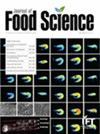Relationship between consumer acceptance, sensory characteristics, and physicochemical characteristics of "Fuji" apples from different origins
Abstract
This study examines the acceptance of young Chinese consumers for different “Fuji” apples, focusing on their sensory characteristics and physicochemical foundations. The sensory attributes of the samples were evaluated using a combination of static descriptive analysis (DA) and temporal check-all-that-apply fading (TCATA-fading) methods. Furthermore, the volatile compounds, soluble sugars, organic acids, and textural parameters of the samples were analyzed. The findings revealed that participants favored apples that were perceived as “sweet,” “crunchy,” “juicy,” and “aromatic.” The results from the DA indicated that certain sensory attributes, such as “sweet,” “vanilla,” “honey,” and “pear” positively influenced acceptance, while attributes like “sour,” “hard,” and “grass” had a negative impact. The findings from both the DA and TCATA-fading methods were consistent with each other. In terms of dynamic evaluation, sweetness, and sourness were the initial perceptions, followed by a range of other flavors. Notably, our data suggested that sweetness perception could be enhanced by attributes such as “honey” and “banana.” Additionally, the sugar-acid ratio and specific volatile compounds, including hexanal, (E)-2-hexenal, β-damascenone, butyl acetate, and propyl 2-methylbutyrate, were found to influence the perception of sweetness in apples.
Practical Application
This study helps to understand the effect of different origins on the acceptance of “Fuji” apples and to know the sensory and material basis for the emergence of such differences. It is beneficial for growers and marketers to improve ‘Fuji’ apples.

 求助内容:
求助内容: 应助结果提醒方式:
应助结果提醒方式:


